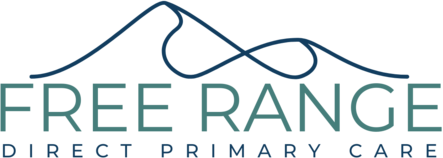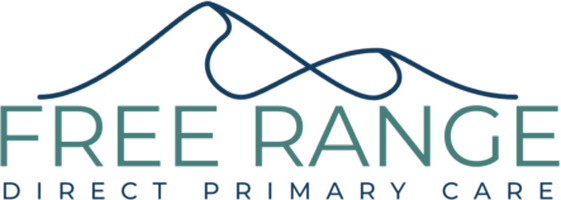By Dr Matthew Johnson
•
September 10, 2025
Welcome to The PEAK! The PEAK, or “Patient Education And Knowledge,” is the monthly newsletter for Free Range Direct Primary Care. This newsletter will hopefully provide you with evidence-based medical knowledge as well as updates regarding the practice. Practice Updates NEW PATIENTS: I am continuing to accepting new patients! Currently, I can see them in 1-2 days for a new patient appointment. If you know of anyone in need of a primary care doctor, please send them my way! REVIEWS: I would love if you can provide a 5-star Google review for my practice! You may do so by visiting here, https://g.page/r/CXhfHK-SrDl6EBM/review . Please let me know if I can improve on anything. Thank you! APPOINTMENTS: If you are in need of an appointment, please schedule here . You may also call or email and I can get you on the schedule. MEDICATION REFILLS: Please text/call (434-337-5934) or email ( drjohnson@frdpc.com ) with medication refill requests. I will get them to your pharmacy as soon as possible. November November is Lung Cancer Awareness Month! In this issue we discuss: Current Lung Cancer Screening Guidelines Smoking Cessation Guidelines Tips on Preparing for Cold and Flu Season Predicting Direct Primary Care Evolution Lung Cancer Screening Lung Cancer Screening: The United States Preventive Services Task Force (USPSTF) recommends annual lung cancer screening with low-dose computed tomography (LDCT) for adults aged 50 to 80 years who have a 20 pack-year smoking history and currently smoke or have quit within the past 15 years. Screening should be discontinued once a person has not smoked for 15 years or develops a health problem that substantially limits life expectancy or the ability or willingness to have curative lung surgery. The American Cancer Society (ACS) aligns with these recommendations, emphasizing the importance of shared decision-making and the elimination of the years-since-quit (YSQ) criterion for beginning or ending screening. Lung Cancer Screening. Choi HK, Mazzone PJ. The Medical Clinics of North America. 2022;106(6):1041-1053. doi:10.1016/j.mcna.2022.07.007. Screening for Lung Cancer: US Preventive Services Task Force Recommendation Statement. Krist AH, Davidson KW, Mangione CM, et al.Jama. 2021;325(10):962-970. doi:10.1001/jama.2021.1117. Screening for Lung Cancer: 2023 Guideline Update From the American Cancer Society. Wolf AMD, Oeffinger KC, Shih TY, et al.CA: A Cancer Journal for Clinicians. 2024 Jan-Feb;74(1):50-81. doi:10.3322/caac.21811. Smoking Cessation The National Comprehensive Cancer Network (NCCN) recommends a multimodal approach to smoking cessation, which includes evidence-based motivational strategies and behavior therapy (counseling), pharmacotherapy, and close follow-up with retreatment as needed. The two most effective pharmacotherapies are combination nicotine replacement therapy (NRT) and varenicline. The American College of Chest Physicians and the American Thoracic Society also emphasize integrating smoking cessation efforts into LDCT screening programs, recommending interventions such as nicotine replacement therapy, bupropion, and varenicline, along with behavioral counseling. Smoking Cessation, Version 3.2022, NCCN Clinical Practice Guidelines in Oncology. Shields PG, Bierut L, Arenberg D, et al. Journal of the National Comprehensive Cancer Network : JNCCN. 2023;21(3):297-322. doi:10.6004/jnccn.2023.0013. An Official American Thoracic Society/American College of Chest Physicians Policy Statement: Implementation of Low-Dose Computed Tomography Lung Cancer Screening Programs in Clinical Practice. Wiener RS, Gould MK, Arenberg DA, et al. American Journal of Respiratory and Critical Care Medicine. 2015;192(7):881-91. doi:10.1164/rccm.201508-1671ST. Pairing Smoking-Cessation Services With Lung Cancer Screening: A Clinical Guideline From the Association for the Treatment of Tobacco Use and Dependence and the Society for Research on Nicotine and Tobacco. Fucito LM, Czabafy S, Hendricks PS, et al. Cancer. 2016;122(8):1150-9. doi:10.1002/cncr.29926. Tips For The Upcoming Cold & Flu Season To prepare for the cold and flu season, several evidence-based strategies can be employed: Vaccination: The Advisory Committee on Immunization Practices (ACIP) recommends annual influenza vaccination for all individuals aged 6 months and older who do not have contraindications. Vaccination should ideally occur before the onset of flu activity, typically by the end of October. We have these available in our office. Just contact Dr. Johnson to schedule for your vaccination. Preventive Behaviors: According to Srivastav et al., preventive behaviors such as frequent hand washing, covering coughs and sneezes, staying home when sick, and avoiding close contact with sick individuals are crucial. These behaviors help reduce the transmission of influenza and other respiratory viruses. Nonpharmaceutical Interventions: During the COVID-19 pandemic, measures such as mask-wearing, physical distancing, and enhanced hygiene practices significantly reduced the transmission of respiratory viruses, including influenza. These interventions can be effective during the flu season as well. Nutritional Support: Rondanelli et al. highlight the role of vitamins and minerals in supporting immune function. Regular supplementation with vitamin C (1-2 g/day) and zinc can reduce the duration and severity of cold symptoms. Vitamin D supplementation is also beneficial, particularly for individuals with deficiency. Antiviral Medications: For those who contract influenza, early initiation of antiviral medications, such as oseltamivir, can reduce the duration of symptoms and the risk of complications. These should be started within 48 hours of symptom onset. Environmental Hygiene: Regular cleaning and disinfecting of frequently touched surfaces can help prevent the spread of viruses. Ensuring good ventilation in indoor spaces is also recommended. In summary, vaccination, preventive behaviors, non-pharmaceutical interventions, nutritional support, antiviral medications, and environmental hygiene are key strategies to prepare for and mitigate the impact of the cold and flu season. Prevention and Control of Seasonal Influenza With Vaccines: Recommendations of the Advisory Committee on Immunization Practices - United States, 2022-23 Influenza Season. Grohskopf LA, Blanton LH, Ferdinands JM, et al. MMWR. Recommendations and Reports : Morbidity and Mortality Weekly Report. Recommendations and Reports. 2022;71(1):1-28. doi:10.15585/mmwr.rr7101a1. Copyright License: CC0 Preventive Behaviors Adults Report Using to Avoid Catching or Spreading Influenza, United States, 2015-16 Influenza Season. Srivastav A, Santibanez TA, Lu PJ, et al. PloS One. 2018;13(3):e0195085. doi:10.1371/journal.pone.0195085. Decreased Influenza Activity During the COVID-19 Pandemic - United States, Australia, Chile, and South Africa, 2020. Olsen SJ, Azziz-Baumgartner E, Budd AP, et al. MMWR. Morbidity and Mortality Weekly Report. 2020;69(37):1305-1309. doi:10.15585/mmwr.mm6937a6. Changes in Influenza and Other Respiratory Virus Activity During the COVID-19 Pandemic - United States, 2020-2021. Olsen SJ, Winn AK, Budd AP, et al. MMWR. Morbidity and Mortality Weekly Report. 2021;70(29):1013-1019. doi:10.15585/mmwr.mm7029a1. Self-Care for Common Colds: The Pivotal Role of Vitamin D, Vitamin C, Zinc, and in Three Main Immune Interactive Clusters (Physical Barriers, Innate and Adaptive Immunity) Involved During an Episode of Common Colds-Practical Advice on Dosages and on the Time to Take These Nutrients/Botanicals in Order to Prevent or Treat Common Colds. Rondanelli M, Miccono A, Lamburghini S, et al. Evidence-Based Complementary and Alternative Medicine : eCAM. 2018;2018:5813095. doi:10.1155/2018/5813095. Clinical Practice Guidelines by the Infectious Diseases Society of America: 2018 Update on Diagnosis, Treatment, Chemoprophylaxis, and Institutional Outbreak Management of Seasonal Influenzaa. Uyeki TM, Bernstein HH, Bradley JS, et al. Clinical Infectious Diseases : An Official Publication of the Infectious Diseases Society of America. 2019;68(6):895-902. doi:10.1093/cid/ciy874. Predicting Direct Primary Care Evolution: A New Dawn for Healthcare By: Nick Soman - Decent Introduction to Direct Primary Care Defining Direct Primary Care and Its Significance in the Healthcare Industry Direct Primary Care (DPC) represents a paradigm shift in healthcare delivery, redefining the patient-provider relationship. This model, where patients pay a fixed monthly fee directly to their primary care provider, excludes the complexities of traditional insurance billing. Its significance lies in its simplicity and patient-centered approach, offering more time for patient care, reduced administrative burdens, and an emphasis on preventative health. Contrasting Direct Primary Care with Traditional Healthcare Models In contrast to the traditional fee-for-service model, which often leads to brief, infrequent patient interactions, DPC fosters an environment where physicians can spend more time with each patient. This allows for comprehensive care, focusing not only on immediate medical issues but also on long-term health planning. The traditional model, often constrained by insurance company policies, can limit the time and scope of care a physician can provide. The Growing Popularity of Direct Primary Care The rise in popularity of Direct Primary Care is a response to growing patient and physician dissatisfaction with the standard healthcare model. Patients are attracted to the transparency, accessibility, and personalized care DPC offers, while physicians appreciate the autonomy and the ability to practice medicine more aligned with their original intent – caring for patients without undue external pressures. The Evolution of Direct Primary Care Historical Development of Direct Primary Care Direct Primary Care began as a grassroots movement in the early 2000s, with physicians seeking an alternative to the high-pressure, high-volume constraints of traditional practice. Initially adopted by a small but passionate group of practitioners, it has since gained momentum, attracting attention as a viable alternative to traditional healthcare delivery. Major Milestones in Direct Primary Care Key milestones in DPC's evolution include the establishment of the Direct Primary Care Coalition, which has played a significant role in advocating for DPC at the policy level, and the growing body of research highlighting DPC's positive impacts on patient health outcomes and satisfaction. Innovations such as integrating electronic health records (EHRs) and telemedicine have also been crucial in expanding DPC’s reach and capabilities. Technology's Role in Direct Primary Care's Growth Technology has been a catalyst in DPC's evolution. Telehealth, for instance, has expanded the reach of DPC physicians, allowing them to offer care remotely. EHRs have streamlined patient data management, making it easier for DPC practices to track patient health outcomes and tailor care to individual needs. Impact of Legislation and Policy on Direct Primary Care Healthcare Policies Influencing Direct Primary Care Healthcare policies at both the federal and state levels have had a significant impact on the growth of DPC. For example, states that have passed legislation recognizing DPC as a non-insurance healthcare model have provided a legal framework for its operation, encouraging more physicians to adopt this model. Policy Shifts and Their Effects on Direct Primary Care Policy shifts like the IRS ruling that allowed Health Savings Accounts (HSAs) to be used for DPC fees have made this model more accessible to a broader population. Conversely, policies that categorize DPC as a form of insurance have created hurdles, limiting its adoption in certain regions. Predicting the Future of Direct Primary Care Forecasting Methods for Direct Primary Care's Evolution Predictive analytics, market trend analyses, and policy trend monitoring are methods used to forecast the future of DPC. These approaches help in understanding how changes in healthcare demand, technology, and legislation might shape the future of DPC. Emerging Trends in Direct Primary Care Future trends in DPC may include an increased focus on integrated care models, where DPC practices work closely with specialists to provide comprehensive care. Another potential trend is the expansion of DPC into more holistic care, encompassing mental health, nutrition, and wellness services. The Influence of Medical Advancements on DPC Advancements in personalized medicine, like genetic testing and tailored treatment plans, are likely to be incorporated into DPC practices. This evolution could lead to even more personalized care plans, improving patient outcomes and satisfaction. Challenges and Opportunities in Direct Primary Care Potential Obstacles for Direct Primary Care Challenges for DPC include misconceptions about its model, varying state laws, and ensuring affordability. Additionally, as DPC grows, maintaining the high level of personalized care that defines the model could become more challenging. Opportunities Stemming from Direct Primary Care Growth Opportunities for DPC include potential reductions in overall healthcare costs and improvements in chronic disease management. For physicians, DPC offers a more satisfying practice environment, potentially reducing burnout. For patients, the model promises more accessible, personalized care. Conclusion: The Promising Future of Direct Primary Care Direct Primary Care stands at the cusp of revolutionizing healthcare delivery. By focusing on patient-centered care, leveraging advancements in technology, and adapting to changes in healthcare policy and demand, DPC is poised to play a pivotal role in shaping the future of healthcare. This model’s emphasis on preventative care, chronic disease management, and personalized patient experiences positions it as a sustainable, effective solution to many of the challenges facing today's healthcare system. Addressing Specific Questions While predicting patient preferences for end-of-life care can be challenging, DPC’s model of extended patient interactions could lead to better understanding and more accurate predictions of patient wishes. Direct Primary Care has been gaining momentum since the early 2000s, emerging as a response to the challenges of traditional healthcare models. Future changes in healthcare likely include an increased focus on models like DPC that prioritize strong patient-provider relationships and integrate advanced technology and personalized care approaches. The Direct Primary Care model is characterized by a direct financial relationship between patients and providers, bypassing traditional insurance, and focusing on accessible, personalized primary care. Direct Primary Care represents not just an alternative to traditional healthcare but a reimagining of the patient-doctor relationship. Its continued evolution and adoption are a testament to its potential to offer more humane, effective, and patient-centered healthcare. As the healthcare landscape continues to evolve, DPC stands as a beacon of innovation and patient advocacy, heralding a new era in healthcare delivery.












